Black And Decker QS540 Handleiding
Bekijk gratis de handleiding van Black And Decker QS540 (6 pagina’s), behorend tot de categorie Schuurmachine. Deze gids werd als nuttig beoordeeld door 51 mensen en kreeg gemiddeld 4.7 sterren uit 26 reviews. Heb je een vraag over Black And Decker QS540 of wil je andere gebruikers van dit product iets vragen? Stel een vraag
Pagina 1/6

General Power Tool Safety Warnings
WARNING! Read all safety warnings and instructions. Failure to follow the
warnings and instructions may result in electric shock, fire and/or serious injury.
Save all warnings and instructions for future reference.
The term “power tool” in the warnings refers to your mains-operated (corded) power
tool or battery-operated (cordless) power tool.
1) Work area safety
a) Keep work area clean and well lit.
Cluttered or dark areas invite accidents.
b) Do not operate power tools in explosive atmospheres, such as in the presence of
flammable liquids, gases or dust
. Power tools create sparks which may ignite the dust
or fumes.
c) Keep children and bystanders away while operating a power tool.
Distractions can
cause you to lose control.
2) Electrical safety
a) Power tool plugs must match the outlet. Never modify the plug in any way. Do not
use any adapter plugs with earthed (grounded) power tools.
Unmodified plugs and
matching outlets will reduce risk of electric shock.
b) Avoid body contact with earthed or grounded surfaces such as pipes, radiators,
ranges and refrigerators.
There is an increased risk of electric shock if your body is
earthed or grounded.
c) Do not expose power tools to rain or wet conditions.
Water entering a power tool
will increase the risk of electric shock.
d) Do not abuse the cord. Never use the cord for carrying, pulling or unplugging the
power tool. Keep cord away from heat, oil, sharp edges or moving parts.
Damaged
or entangled cords increase the risk of electric shock.
e) When operating a power tool outdoors, use an extension cord suitable for
outdoor use.
Use of a cord suitable for outdoor use reduces the risk of electric shock.
f) If operating a power tool in a damp location is unavoidable, use a residual current
device (RCD) protected supply.
Use of an RCD reduces the risk of electric shock.
3) Personal safety
a) Stay alert, watch what you are doing and use common sense when operating a
power tool. Do not use a power tool while you are tired or under the influence of
drugs, alcohol or medication.
A moment of inattention while operating power tools
may result in serious personal injury.
b) Use personal protective equipment. Always wear eye protection.
Protective
equipment such as dust mask, non-skid safety shoes, hard hat, or hearing protection
used for appropriate conditions will reduce personal injuries.
c) Prevent unintentional starting. Ensure the switch is in the off-position before
connecting to power source and/or battery pack, picking up or carrying the tool.
Carrying power tools with your finger on the switch or energising power tools that have
the switch on invites accidents.
d) Remove any adjusting key or wrench before turning the power tool on.
A wrench
or a key left attached to a rotating part of the power tool may result in personal injury.
e) Do not overreach. Keep proper footing and balance at all times.
This enables better
control of the power tool in unexpected situations.
f) Dress properly. Do not wear loose clothing or jewellery. Keep your hair, clothing
and gloves away from moving parts.
Loose clothes, jewellery or long hair can be
caught in moving parts.
g) If devices are provided for the connection of dust extraction and collection
facilities, ensure these are connected and properly used.
Use of dust collection can
reduce dust-related hazards.
4) Power tool use and care
a) Do not force the power tool. Use the correct power tool for your application.
The
correct power tool will do the job better and safer at the rate for which it was designed.
b) Do not use the power tool if the switch does not turn it on and off.
Any power tool
that cannot be controlled with the switch is dangerous and must be repaired.
c) Disconnect the plug from the power source and/or the battery pack from the
power tool before making any adjustments, changing accessories, or storing
power tools.
Such preventive safety measures reduce the risk of starting the power tool
accidentally.
d) Store idle power tools out of the reach of children and do not allow persons
unfamiliar with the power tool or these instructions to operate the power tool.
Power tools are dangerous in the hands of untrained users.
e) Maintain power tools. Check for misalignment or binding of moving parts,
breakage of parts and any other condition that may affect the power tool’s
operation. If damaged, have the power tool repaired before use.
Many accidents are
caused by poorly maintained power tools.
f) Keep cutting tools sharp and clean.
Properly maintained cutting tools with sharp
cutting edges are less likely to bind and are easier to control.
g) Use the power tool, accessories and tool bits etc., in accordance with these
instructions, taking into account the working conditions and the work to be
performed.
Use of the power tool for operations different from those intended could
result in a hazardous situation.
5) Battery tool use and care
a) Recharge only with the charger specified by the manufacturer.
A charger that is
suitable for one type of battery pack may create a risk of fire when used with another
battery pack.
b) Use power tools only with specifically designated battery packs. Use of any other
battery packs may create a risk of injury and fire.
c) When battery pack is not in use, keep it away from other metal objects like paper
clips, coins, keys, nails, screws, or other small metal objects that can make a
connection from one terminal to another.
Shorting the battery terminals together may
cause burns or a fire.
d) Under abusive conditions, liquid may be ejected from the battery, avoid contact. If
contact accidentally occurs, flush with water. If liquid contacts eyes, additionally
seek medical help.
Liquid ejected from the battery may cause irritation or burns.
6) Service
a) Have your power tool serviced by a qualified repair person using only identical
replacement parts.
This will ensure that the safety of the power tool is maintained.
SPECIFIC SAFETY RULES
• Hold power tools by insulated gripping surfaces when performing an operation where
the cutting tool may contact hidden wiring or its own cord. Contact with a "live" wire will
make exposed metal parts of the tool "live" and shock the operator.
• Always use proper eye protection and a respirator when sanding.
• Sanding of lead-based paint is not recommended. See Sanding Lead Based Paint for
additional information before sanding paint.
• Clean your tool out periodically.
WARNING: Some dust created by power sanding, sawing, grinding, drilling, and
other construction activities contains chemicals known to the State of California to
cause cancer, birth defects or other reproductive harm. Some examples of these
chemicals are:
• lead from lead-based paints,
• crystalline silica from bricks and cement and other masonry products, and
• arsenic and chromium from chemically-treated lumber.
Your risk from these exposures varies, depending on how often you do this type of
work. To reduce your exposure to these chemicals: work in a well ventilated area, and
work with approved safety equipment, such as those dust masks that are specially
designed to filter out microscopic particles.
• Avoid prolonged contact with dust from power sanding, sawing, grinding, drilling,
and other construction activities. Wear protective clothing and wash exposed areas
with soap and water. Allowing dust to get into your mouth, eyes, or lay on the skin may
promote absorption of harmful chemicals.
WARNING: Use of this tool can generate and/or disperse dust, which may cause
serious and permanent respiratory or other injury. Always use NIOSH/OSHA
approved respiratory protection appropriate for the dust exposure. Direct particles
away from face and body.
WARNING: ALWAYS use safety glasses. Everyday eye glasses are NOT safety
glasses. Also use face or dust mask if cutting operation is dusty. ALWAYS WEAR
CERTIFIED SAFETY EQUIPMENT:
•
ANSI Z87.1 eye protection (CAN/CSA Z94.3)
•
ANSI S12.6 (S3.19) hearing protection
•
NIOSH/OSHA/MSHA respiratory protection
SAFETY GUIDELINES - DEFINITIONS
It is important for you to read and understand this manual. The information it contains relates to protecting YOUR SAFETY and PREVENTING
PROBLEMS. The symbols below are used to help you recognize this information.
DANGER: Indicates an imminently hazardous situation which, if not avoided, will result
in death or serious injury.
WARNING: Indicates a potentially hazardous situation which, if not avoided, could
result in death or serious injury.
CAUTION: Indicates a potentially hazardous situation which, if not avoided, may result
in minor or moderate injury.
CAUTION: Used without the safety alert symbol indicates a potentially hazardous situation
which, if not avoided, may result in property damage.
Symbols
The label on your tool may include the following symbols.
V ..........................volts A..........................amperes
Hz ........................hertz W ........................watts
min........................minutes ......................alternating current
......................direct current n o........................no load speed
.......................... Class II Construction ........................earthing terminal
..........................safety alert symbol .../min ..................revolutions or
reciprocations per minute
Cat. No. QS540 Form No. 494402-00 Rev. 1 MAR. ‘08
Copyright © 2008 Black & Decker Printed in China
KEY INFORMATION YOU SHOULD KNOW:
• Never operate the sander without recommended
sandpaper properly installed on the base.
• Do not push down—let the sander do the work.
• Extended drywall sanding is not recommended.
VEA EL ESPAÑOL EN LA CONTRAPORTADA.
SAVE THIS MANUAL FOR FUTURE REFERENCE.
INSTRUCTIVO DE OPERACIÓN, CENTROS DE SERVICIO Y
PÓLIZA DE GARANTÍA. ADVERTENCIA: LÉASE ESTE
INSTRUCTIVO ANTES DE USAR EL PRODUCTO.
INSTRUCTION MANUAL
Catalog No. QS540
F
F
F
F
FF
F
F
F
F
FFi
i
i
i
ii
i
i
i
i
iin
n
n
n
nn
n
n
n
n
nni
i
i
i
ii
i
i
i
i
iis
s
s
s
ss
s
s
s
s
ss h
h
h
h
hh
h
h
h
h
hhi
i
i
i
ii
i
i
i
i
ii n
n
n
n
nn
n
n
n
n
nng
g
g
g
gg
g
g
g
g
gg
S
S
S
S
SS
S
S
S
S
SSa
a
a
a
aa
a
a
a
a
aan
n
n
n
nn
n
n
n
n
nnd
d
d
d
dd
d
d
d
d
dde
e
e
e
ee
e
e
e
e
eer
r
r
r
rr
r
r
r
r
rr
1
FRONT
2
BEFORE RETURNING THIS PRODUCT
FOR ANY REASON PLEASE CALL
1-800-544-6986
BEFORE YOU CALL, HAVE THE CATALOG No. AND DATE CODE AVAILABLE. IN MOST CASES, A
BLACK & DECKER REPRESENTATIVE CAN RESOLVE THE PROBLEM OVER THE PHONE. IF YOU HAVE A
SUGGESTION OR COMMENT, GIVE US ACALL. YOUR FEEDBACK IS VITAL TO BLACK & DECKER.
T
THANK
HANK YOU
YOU FOR
FOR CHOOSING
CHOOSING B
BLACK
LACK &
&D
DECKER
ECKER!
!
G
GO
OT
TO
OWWW
WWW.B
.BLACKAND
LACKAND D
DECKER
ECKER.
.COM
COM /N
/NEW
EWO
OWNER
WNER
T
TO
OREGISTER
REGISTER YOUR
YOUR NEW
NEW PRODUCT
PRODUCT.
.

Safety Warnings and Instructions: Sanders
• ALWAYS WEAR EYE AND RESPIRATORY PROTECTION.
• Clean your tool out periodically.
Other Important Safety Warnings and Instructions
Extension Cords
When using an extension cord, be sure to use one heavy enough to carry the current your
product will draw. An undersized cord will cause a drop in line voltage resulting in loss of
power and overheating. The following table shows the correct size to use depending on cord
length and nameplate ampere rating. If in doubt, use the next heavier gage. The smaller the
gage number, the heavier the cord.
Sanding
Lead based Paint
Sanding of lead based paint is NOT RECOMMENDED due to the difficulty of controlling the
contaminated dust. The greatest danger of lead poisoning is to children and pregnant
women.
Since it is difficult to identify whether or not a paint contains lead without a chemical analysis,
we recommend the following precautions when sanding any paint:
Personal Safety
• No children or pregnant women should enter the work area where the paint sanding is
being done until all clean up is completed.
• A dust mask or respirator should be worn by all persons entering the work area. The filter
should be replaced daily or whenever the wearer has difficulty breathing.
NOTE: Only those dust masks suitable for working with lead paint dust and fumes should
be used. Ordinary painting masks do not offer this protection. See your local hardware
dealer for the proper (NIOSH approved) mask.
• NO EATING, DRINKING or SMOKING should be done in the work area to prevent
ingesting contaminated paint particles. Workers should wash and clean up BEFORE
eating, drinking or smoking. Articles of food, drink, or smoking should not be left in the work
area where dust would settle on them.
Environmental Safety
• Paint should be removed in such a manner as to minimize the amount of dust generated.
• Areas where paint removal is occurring should be sealed with plastic sheeting of 4 mils
thickness.
• Sanding should be done in a manner to reduce tracking of paint dust outside the work area.
Cleaning and Disposal
• All surfaces in the work area should be vacuumed and thoroughly cleaned daily for the
duration of the sanding project. Vacuum filter bags should be changed frequently.
• Plastic drop cloths should be gathered up and disposed of along with any dust chips or
other removal debris. They should be placed in sealed refuse receptacles and disposed of
through regular trash pick-up procedures. During clean up, children and pregnant women
should be kept away from the immediate work area.
• All toys, washable furniture and utensils used by children should be washed thoroughly
before being used again.
Motor
Be sure your power supply agrees with nameplate marking. 120 Volts AC only means your
tool will operate on standard 60 Hz household power. Do not operate AC tools on DC. A
rating of 120 volts AC/DC means that you tool will operate on standard 60 Hz AC or DC
power. This information is printed on the nameplate. Lower voltage will cause loss of power
and can result in over-heating. All Black & Decker tools are factory-tested; if this tool does
not operate, check the power supply.
Assembly/Adjustment Set-Up
WARNING: Always unplug sander from power supply before any of the following
operations.
Attaching Sandpaper
To operate the paper clamps on your sander, simply lift them up with your thumb, as shown
in Figure 1. Rotate the clamp lever downward until the clamp is fully opened.
Insert one short edge of the paper under the clamp. Push edge squarely up against the flat
wall of the platen and close the paper clamp on that side. Wrap the sandpaper around to fit
the other edge under the opposite paper clamp. Push as much paper under the second
clamp as possible before securing the paper clamp. Any slack in the paper will reduce
sanding performance.
NOTE: The QS540 comes with the paper punch shown in figure 2. The punch may be
permanently attached to a workbench by screwing it down using the two holes provided. If it
is on a work surface simply press the sander ( with sandpaper firmly attached ) down on the
punch to create the dust collection holes. If it is hand held simply press the punch against
the sander pad.
Operating Instructions
WARNING: To reduce the risk of serious personal injury, read, understand and follow all
important safety warnings and instructions prior to using this tool.
Switch
To turn the tool ON, push the portion of the dust protected switch marked "I". To turn the tool
OFF, push the portion of the switch marked "O".
Operation
Grasp the sander and turn it ON. Move it in long, sweeping strokes along the surface, letting
it do the work. Utilize an even pressure across the sanding pad. Excessive pressure in the
corner area may cause damage. Pushing down on the tool while sanding actually slows the
removal rate and produces an inferior quality finish. Check your work often. Sander is
capable of removing material rapidly.
Dust Extraction
WARNING: Collected sanding dust from sanding surface coatings (polyurethane,
linseed oil, etc.) can self-ignite in sander dust bag or elsewhere and cause fire. To
reduce risk, empty bag frequently and strictly follow sander manual and coating
manufacturer's instructions.
Your sander comes equipped with a cloth canister to collect the dust generated while
sanding. To attach the canister onto the sander simply slide it firmly onto the dust extraction
port at the back of the sander and twist it slightly.
To empty the dust canister, remove it from the sander by simply twisting slightly and pulling it
straight back. Dump the sanding debris into an appropriate trash receptacle.
You may, if you prefer, attach a vacuum cleaner to the tool to collect the dust as you sand.
Simply remove the dust bag, and install a vacuum hose.
Ensure that the vacuum cleaner can be placed such that it will not tip over or interfere with
the motion of the sander. If this cannot be done, do not use the vacuum cleaner. Turn on the
vacuum cleaner before beginning to sand and turn it off after turning off the sander. Empty
vacuum cleaner as required.
Maintenance / Cleaning
Use only mild soap and damp cloth to clean the tool. Never let any liquid get inside
the tool; never immerse any part of the tool into a liquid.
IMPORTANT: To assure product SAFETY and RELIABILITY, repairs, maintenance and
adjustment should be performed by authorized service centers or other qualified service
personnel, always using identical replacement parts.
ACCESSORIES
Recommended accessories for use with your tool are available from your local dealer or
authorized service center. If you need assistance regarding accessories, please call:
1-800-54-HOW TO (1-800-544-6986).
WARNING: The use of any accessory not recommended for use with this tool could be
hazardous.
SERVICE INFORMATION
All Black & Decker Service Centers are staffed with trained personnel to provide customers
with efficient and reliable power tool service. Whether you need technical advice, repair, or
genuine factory replacement parts, contact the Black & Decker location nearest you. To find
your local service location, refer to the yellow page directory under "Tools—Electric" or call:
1-800-544-6986 or visit www.blackanddecker.com
FULL TWO-YEAR HOME USE WARRANTY
Black & Decker (U.S.) Inc. warrants this product for two years against any defects in
material or workmanship. The defective product will be replaced or repaired at no charge in
either of two ways.
The first, which will result in exchanges only, is to return the product to the retailer from
whom it was purchased (provided that the store is a participating retailer). Returns should be
made within the time period of the retailer’s policy for exchanges (usually 30 to 90 days after
the sale). Proof of purchase may be required. Please check with the retailer for their specific
return policy regarding returns that are beyond the time set for exchanges.
The second option is to take or send the product (prepaid) to a Black & Decker owned or
authorized Service Center for repair or replacement at our option. Proof of purchase may be
required.Black & Decker owned and authorized Service Centers are listed under
"Tools-Electric" in the yellow pages of the phone directory.
This warranty does not apply to accessories. This warranty gives you specific legal rights
and you may have other rights which vary from state to state or province to province.
Should you have any questions, contact the manager of your nearest Black & Decker
Service Center. This product is not intended for commercial use.
FREE WARNING LABEL REPLACEMENT: If your warning labels become illegible or are
missing, call for a free replacement.1-800-544-6986
Minimum Gage for Cord Sets
Volts Total Length of Cord in Feet
120V 0-25 26-50 51-100 101-150
(0-7,6m) (7,6-15,2m) (15,2-30,4m) (30,4-45,7m)
240V 0-50 51-100 101-200 201-300
(0-15,2m) (15,2-30,4m) (30,4-60,9m) (60,9-91,4m)
Ampere Rating
More Not more American Wire Gage
Than Than 0 - 6 18 16 16 14
6 - 10 18 16 14 12
10 - 12 16 16 14 12
12 - 16 14 12 Not Recommended
TROUBLESHOOTING
Problem Possible Cause Possible Solution
• Unit will not start. • Cord not plugged in. • Plug tool into a working
outlet.
• Circuit fuse is blown. • Replace circuit fuse.
(If the product repeatedly
causes the circuit fuse to
blow, discontinue use
immediately and have it
serviced at a Black &
Decker service center or
authorized servicer.)
• Circuit breaker is tripped. • Reset circuit breaker.
(If the product repeatedly
causes the circuit
breaker to trip,
discontinue use
immediately and have it
serviced at a Black &
Decker service center or
authorized servicer.)
• Cord or switch is damaged. • Have cord or switch
replaced at Black
& Decker Service Center
or Authorized Servicer
For assistance with your product, visit our website www.blackanddecker.com for the
location of the service center nearest you or call the BLACK & DECKER help line at
1-800-544-6986.
See ‘Tools-
Electric’
– Yellow Pages –
for Service &
Sales
Black & Decker (U.S.)
Inc.,
701 E. Joppa Rd.
Towson, MD 21286
U.S.A.
N° de catalogue QS540
MODE D’EMPLOI
AVANT DE RETOURNER CE PRODUIT POUR QUELQUE
RAISON QUE CE SOIT, COMPOSER LE
1-800-544-6986
AVANT D’APPELER, AYEZ EN MAIN LE N° DE CATALOGUE ET LE CODE DE DATE. DANS LA PLUPART
DES CAS, UN REPRÉSENTANT DE BLACK & DECKER PEUT RÉSOUDRE LE PROBLÈME PAR
TÉLÉPHONE. SI VOUS AVEZ UNE SUGGESTION OU UN COMMENTAIRE, APPELEZ-NOUS. VOS
IMPRESSIONS SONT CRUCIALES POUR BLACK & DECKER.
M
MERCI
ERCI D
D’
’A
AVOIR
VOIR CHOISI
CHOISI B
BLACK
LACK & D
& DECKER
ECKER !
!
V
VISITEZ
ISITEZ WWW
WWW.B
.BLACKAND
LACKANDD
DECKER
ECKER.
.COM
COM/N
/NEW
EWO
OWNER
WNER
POUR
POUR ENREGISTRER
ENREGISTRER VOTRE
VOTRE NOUVEAU
NOUVEAU PRODUIT
PRODUIT.
.
P
P
P
P
PP
P
P
P
P
PPo
o
o
o
oo
o
o
o
o
oon
n
n
n
nn
n
n
n
n
nnc
c
c
c
cc
c
c
c
c
cce
e
e
e
ee
e
e
e
e
eeu
u
u
u
uu
u
u
u
u
uus
s
s
s
ss
s
s
s
s
sse
e
e
e
ee
e
e
e
e
ee
d
d
d
d
dd
d
d
d
d
dde
e
e
e
ee
e
e
e
e
ee
f
f
f
f
ff
f
f
f
f
ffi
i
i
i
ii
i
i
i
i
iin
n
n
n
nn
n
n
n
n
nn i
i
i
i
ii
i
i
i
i
iit
t
t
t
tt
t
t
t
t
tti
i
i
i
ii
i
i
i
i
iio
o
o
o
oo
o
o
o
o
oon
n
n
n
nn
n
n
n
n
nn
RENSEIGNEMENTS IMPORTANTS
• Ne jamais utiliser la ponceuse sans avoir au préalable
installé le disque approprié sur le tampon.
• Ne pas exercer une pression excessive sur
l’outil - laisser la ponceuse travailler seule.
• Il est déconseillé de poncer pendant de longues
durées des murs secs avec l’outil.
CONSERVER CE MANUEL POUR UN USAGE ULTÉRIEUR.
Avertissements de sécurité généraux pour les outils
électriques
AVERTISSEMENT! Lire tous les avertissements de sécurité et toutes les
directives. Le non-respect des avertissements et des directives pourrait se solder
par un choc électrique, un incendie et/ou une blessure grave.
Conserver tous les avertissements et toutes les directives pour un usage
ultérieur.
Le terme «outil électrique» cité dans les avertissements se rapporte à votre outil
électrique à alimentation sur secteur (avec fil) ou par piles (sans fil).

· le plomb dans les peintures à base de plomb,
· la silice cristalline dans les briques et le ciment et autres produits de maçonnerie,
· l’arsenic et le chrome dans le bois de sciage ayant subi un traitement chimique.
Le risque associé à de telles expositions varie selon la fréquence avec laquelle on effectue
ces travaux. Pour réduire l’exposition à de tels produits, il faut travailler dans un endroit bien
aéré et utiliser le matériel de sécurité approprié, tel un masque anti-poussières
spécialement conçu pour filtrer les particules microscopiques.
• Éviter tout contact prolongé avec la poussière soulevée par cet outil ou autres outils
électriques. Porter des vêtements de protection et nettoyer les parties exposées du
corps avec de l’eau savonneuse. S’assurer de bien se protéger afin d’éviter d’absorber
par la bouche, les yeux ou la peau des produits chimiques nocifs.
AVERTISSEMENT :
:
:
:
:: Cet outil peut produire et répandre de la poussière susceptible
de causer des dommages sérieux et permanents au système respiratoire. Toujours
utiliser un appareil respiratoire anti-poussières approuvé par le NIOSH ou l’OSHA. Diriger
les particules dans le sens opposé du visage et du corps.
AVERTISSEMENT : TOUJOURS porter des lunettes de sécurité. Les lunettes de
vue ne constituent PAS des lunettes de sécurité. Utiliser également un masque
facial ou anti-poussière si l’opération de découpe génère de la poussière.
TOUJOURS PORTER UN ÉQUIPEMENT DE PROTECTION HOMOLOGUÉ :
• protection oculaire conforme à la norme ANSI Z87.1 (CAN/CSA Z94.3);
• protection auditive ANSI S12.6 (S3.19);
• protection des voies respiratoires conformes aux normes NIOSH/OSHA/MSHA.
LIGNES DIRECTRICES EN MATIÈRE DE SÉCURITÉ - DÉFINITIONS
Il est important que vous lisiez et compreniez ce mode d’emploi. Les informations qu’il
contient concernent VOTRE SÉCURITÉ et visent à ÉVITER TOUT PROBLÈME. Les
symboles ci-dessous servent à vous aider à reconnaître cette information.
DANGER : Indique une situation dangereuse imminente qui, si elle n’est pas évitée, causera
la mort ou des graves blessures.
AVERTISSEMENT : Indique une situation potentiellement
dangereuse qui, si elle n’est pas évitée, pourrait causer la mort ou de graves blessures.
MISE EN GARDE : Indique une situation potentiellement dangereuse qui, si elle n’est pas
évitée, pourrait causer des blessures mineures ou modérées.
MISE EN GARDE : Utilisé sans le symbole d’alerte à la sécurité, indique une situation
potentiellement dangereuse qui, si elle n’est pas évitée, peut résulter en des dommages à la
propriété.
Symboles
L’étiquette de l’outil peut comporter les symboles suivants:
V ....................................volts A..........................ampères
Hz ..................................hertz W ........................watts
min..................................minutes ......................courant alternatif
................................courant continu n o ........................sous vide
.................................... Construction de classe II ............................ borne de mise à la
minute
....................................symbole d´avertissement .../min ..................tours ou courses
à la minute
Mesures de sécurité : Ponceuses
• TOUJOURS PORTER DES LUNETTES DE SÉCURITÉ.
• Nettoyer l’outil régulièrement.
Autres mesures de sécurité importantes
Cordons de rallonge
Lorsqu'on se sert d'un cordon de rallonge, s'assurer qu'il est de calibre approprié pour la
tension nécessaire au fonctionnement de l'outil. L'utilisation d'un cordon de calibre inférieur
occasionne une baisse de tension entraînant une perte de puissance et la surchauffe. Le
tableau suivant indique le calibre approprié selon la longueur du cordon et les mentions de
la plaque signalétique de l'outil. En cas de doute, utiliser un cordon de calibre supérieur. Le
chiffre indiquant le calibre est inversement proportionnel au calibre du cordon.
Ponçage
Peintue à base de plomb
IL N’EST PAS RECOMMANDÉ de poncer de la peinture à base de plomb puisqu’il est
difficile d’en maîtriser la poussière contaminée. Ce genre de ponçage présente de sérieux
risques d’empoisonnement au plomb pour les femmes enceintes et les enfants.
Puisqu’il est difficile de déterminer si la peinture renferme du plomb sans en faire une
analyse chimique, il est conseillé de se conformer aux mesures suivantes lors du ponçage
de tout type de peinture.
Sécurité personnelle
• Ne laisser aucun enfant ni aucune femme enceinte entrer dans la pièce où il y a ponçage
de peinture jusqu’à ce que la pièce soit nettoyée.
• Toute personne entrant dans la pièce de travail devrait porter un masque ou un
respirateur. L’utilisateur devrait en remplacer le filtre chaque jour ou dès qu’il éprouve de
la difficulté à respirer. Il faut seulement utiliser des masques conçus pour leNOTE :
travail en présence de poussières ou de vapeurs de plomb. Les masques ordinaires ne
sont pas conçus à cet effet. Consulter le quincaillier pour choisir le masque approprié.
• IL EST DÉCONSEILLÉ DE MANGER, DE BOIRE ET DE FUMER dans la pièce de travail
afin de ne pas ingérer de particules contaminées. L’utilisateur doit se laver et se nettoyer
AVANT de manger, de boire ou de fumer. Il ne faut pas laisser dans la pièce de travail de
la nourriture, des boissons ou des cigarettes car de la poussière pourrait se déposer sur
ces articles.
Protection de l’environnement
• Il faut enlever la peinture de manière à produire un minimum de poussière.
• Il faut sceller la zone de travail à l’aide de feuilles de plastique d’une épaisseur minimale
de 4 mils.
• Il faut poncer de façon à réduire la propagation de la poussière hors de la pièce de travail.
Nettoyage et déchets
• Il faut bien aspirer toutes les surfaces de la pièce de travail et les nettoyer à fond chaque
jour pendant la durée des travaux. Il faut remplacer fréquemment le filtre de l’aspirateur.
• Ramasser les feuilles de plastique et les jeter avec la poussière et les autres débris dans
des contenants étanches à placer avec les ordures ménagères pour l’enlèvement. Tenir
les enfants et les femmes enceintes à l’écart de la zone de travail pendant les travaux de
nettoyage.
• Il faut nettoyer à fond les jouets, les meubles et les ustensiles des enfants avant de les
utiliser de nouveau.
Moteur
S’assurer que l’intensité nominale du cordon d’alimentation correspond à celle indiquée sur
la plaque signalétique; sur cette dernière, la mention «120 V c.a.» signifie que l’outil ne doit
être branché que dans une prise résidentielle standard de courant alternatif de 60 Hz et
non pas dans une prise de courant continu, alors que «120 V c.a. / c.c.» signifie que l’outil
peut fonctionner sur une prise standard de 60 Hz de courant alternatif ou continu. Ces
renseignements sont indiqués sur la plaque signalétique. Une tension inférieure à celle
indiquée pourrait entraîner une perte de puissance et une surchauffe. Tous les outils Black
& Decker sont soumis à des essais en usine; si cet outil ne fonctionne pas, on doit d’abord
vérifier l’intensité nominale du cordon d’alimentation.
Montage et réglage
AVERTISSEMENT : Toujours débrancher la sableuse avant de faire les opérations
suivantes.
1) Sécurité du lieu de travail
a) Tenir la zone de travail propre et bien éclairée.
Les endroits sombres sont souvent
des causes d'accidents.
b) Ne pas faire fonctionner d’outils électriques dans un milieu déflagrant, soit en
présence de liquides inflammables, de gaz ou de poussière.
Les outils
électriques produisent des étincelles qui peuvent enflammer la poussière ou les vapeurs.
c) Éloigner les enfants et les curieux au moment d’utiliser un outil électrique.
Une
distraction pourrait vous en faire perdre la maîtrise.
2) Sécurité en matière d’électricité
a) Les fiches des outils électriques doivent correspondre à la prise. Ne jamais
modifier la fiche en aucune façon.
Ne jamais utiliser de fiche d’adaptation avec un
outil électrique mis à la terre. Le risque de choc électrique sera réduit par l’utilisation
de fiches non modifiées correspondant à la prise.
b) Éviter tout contact physique avec des surfaces mises à la terre comme des
tuyaux, des radiateurs, des cuisinières et des réfrigérateurs.
Le risque de choc
électrique est plus élevé si votre corps est mis à la terre.
c) Ne pas exposer les outils électriques à la pluie ou à d'autres conditions où il
pourrait être mouillé.
La pénétration de l’eau dans un outil électrique augmente le
risque de choc électrique.
d) Ne pas utiliser abusivement le cordon d’alimentation. Ne jamais utiliser le
cordon pour transporter, tirer ou débrancher un outil électrique. Tenir le cordon
éloigné de la chaleur, de l’huile, des bords tranchants ou des pièces mobiles.
Les cordons endommagés ou emmêlés augmentent les risques de choc électrique.
e) Pour l’utilisation d’un outil électrique à l’extérieur, se servir d’une rallonge
convenant à une telle utilisation.
L’utilisation d’une rallonge conçue pour l’extérieur
réduit les risques de choc électrique.
f) S’il est impossible d’éviter l’utilisation d’un outil électrique dans un endroit
humide, utiliser une source d’alimentation dotée d’un disjoncteur de fuite à la
terre.
L’utilisation de ce type de disjoncteur réduit les risques de choc électrique.
3) Sécurité personnelle
a) Être vigilant, surveiller le travail effectué et faire preuve de jugement lorsqu’un
outil électrique est utilisé. Ne pas utiliser d’outil électrique en cas de fatigue ou
sous l’influence de drogues, d’alcool ou de médicaments.
Un simple moment
d’inattention en utilisant un outil électrique peut entraîner des blessures corporelles
graves.
b) Utiliser des équipements de protection individuelle. Toujours porter une
protection oculaire.
L’utilisation d’équipements de protection comme un masque
antipoussière, des chaussures antidérapantes, un casque de sécurité ou des
protecteurs auditifs lorsque la situation le requiert réduira les risques de blessures
corporelles.
c) Empêcher les démarrages intempestifs. S’assurer que l’interrupteur se trouve à
la position d’arrêt avant de relier l’outil à une source d’alimentation et/ou
d’insérer un bloc-piles, de ramasser ou de transporter l’outil.
Transporter un outil
électrique alors que le doigt repose sur l’interrupteur ou brancher un outil électrique
dont l’interrupteur est à la position de marche risque de provoquer un accident.
d) Retirer toute clé de réglage ou clé standard avant de démarrer l’outil.
Une clé
standard ou une clé de réglage attachée à une partie pivotante peut causer des blessures.
e) Ne pas trop tendre les bras. Conserver son équilibre en tout temps.
Cela permet
de mieux maîtriser l’outil électrique dans les situations imprévues.
f) S’habiller de manière appropriée. Ne pas porter de vêtements amples ni de
bijoux. Garder les cheveux, les vêtements et les gants à l’écart des pièces
mobiles.
Les vêtements amples, les bijoux ou les cheveux longs risquent de rester
coincés dans les pièces mobiles.
g) Si des composants sont fournis pour le raccordement de dispositifs de
dépoussiérage et de ramassage, s’assurer que ceux-ci sont bien raccordés et
utilisés.
L’utilisation d’un dispositif de dépoussiérage peut réduire les dangers
engendrés par les poussières.
4) Utilisation et entretien d’un outil électrique
a) Ne pas forcer un outil électrique. Utiliser l’outil électrique approprié à
l’application.
L’outil électrique approprié effectuera un meilleur travail, de façon plus
sûre et à la vitesse pour laquelle il a été conçu.
b) Ne pas utiliser un outil électrique dont l’interrupteur est défectueux.
Tout outil
électrique dont l’interrupteur est défectueux est dangereux et doit être réparé.
c) Débrancher la fiche du secteur ou le bloc-piles de l’outil électrique avant de faire
tout réglage ou changement d’accessoire, ou avant de ranger l’outil
électrique.
Ces mesures préventives réduisent les risques de démarrage accidentel
de l’outil électrique.
d) Ranger les outils électriques hors de la portée des enfants, et ne permettre à
aucune personne n’étant pas familière avec un outil électrique (ou son manuel
d’instruction) d’utiliser ce dernier
. Les outils électriques deviennent dangereux entre
les mains d’utilisateurs inexpérimentés.
e) Entretenir les outils électriques. Vérifier les pièces mobiles pour s’assurer
qu’elles sont bien alignées et tournent librement, qu’elles sont en bon état et ne
sont affectées par aucun trouble susceptible de nuire au bon
fonctionnement de l’outil électrique
.
En cas de dommage, faire réparer l’outil
électrique avant toute nouvelle utilisation.
Beaucoup d’accidents sont causés par
des outils électriques mal entretenus.
f) S’assurer que les outils de coupe sont aiguisés et propres.
Les outils de coupe
bien entretenus et affûtés sont moins susceptibles de se coincer et sont plus faciles
à contrôler.
g) Utiliser l’outil électrique, les accessoires, les forets, etc. conformément aux
présentes directives en tenant compte des conditions de travail et du travail à
effectuer.
L’utilisation d’un outil électrique pour toute opération autre que celle pour
laquelle il a été conçu est dangereuse.
5) Utilisation et entretien du bloc-piles
a) Ne recharger l’outil qu’au moyen du chargeur précisé par le fabricant.
L’utilisation
d’un chargeur qui convient à un type de bloc-piles risque de provoquer un incendie s’il
est utilisé avec un autre type de bloc-piles.
b) Utiliser les outils électriques uniquement avec les blocs-piles conçus à cet effet.
L’utilisation de tout autre bloc-piles risque de causer des blessures ou un incendie.
c) Lorsque le bloc-piles n’est pas utilisé, le tenir éloigné des objets métalliques,
notamment des trombones, de la monnaie, des clés, des clous, des vis, etc., qui
peuvent établir une connexion entre les deux bornes.
Le court-circuit des bornes du
bloc-piles risque de provoquer des étincelles, des brûlures ou un incendie.
d) En cas d’utilisation abusive, le liquide peut gicler hors du bloc-piles, éviter tout
contact. Si un contact accidentel se produit, laver à grande eau. Si le liquide entre
en contact avec les yeux, obtenir des soins médicaux.
Le liquide qui gicle hors du
bloc-piles peut provoquer des irritations ou des brûlures.
6) Réparation
a) Faire réparer l’outil électrique par un réparateur professionnel en n’utilisant que
des pièces de rechange identiques
. Cela permettra de maintenir une utilisation
sécuritaire de l’outil électrique.
RÈGLES DE SÉCURITÉ SPÉCIFIQUES
• Saisir l’outil par ses surfaces de prises isolées lorsque l’outil peut entrer enélectrique
contact avec des fils cachés ou son cordon. En cas de contact avec un fil sous tension,
les pièces métalliques de l’outil seront sous tension et l’utilisateur subira des secousses
électriques.
• Toujours porter des lunettes de protection et un appareil respiratoire antipoussière
pendant le ponçage.
• Le ponçage de peintures à base de plomb n’est pas recommandé. Se reporter à la
section Mesures de précaution concernant le ponçage de peinture Précautions à
prendre pour poncer les peintures pour plus d’informations quant au ponçage des
peintures.
• Nettoyer l’outil régulièrement.
AVERTISSEMENT : certains outils électriques, tels que les sableuses, les scies, les
meules, les perceuses ou certains autres outils de construction, peuvent produire
de la poussière contenant des produits chimiques reconnus par l’État de la
Californie comme étant susceptibles d’entraîner le cancer, des malformations
congénitales ou pouvant être nocifs pour le système reproductif. Parmi ces
produits chimiques, on retrouve :
Calibre minimal des cordons de rallonge
Tension Longueur totale du cordon en pieds
120V 0-25 26-50 51-100 101-150
(0-7,6m) (7,6-15,2m) (15,2-30,4m) (30,4-45,7m)
240V 0-50 51-100 101-200 201-300
(0-15,2m) (15,2-30,4m) (30,4-60,9m) (60,9-91,4m)
Intensité (A)
Au Au Calibre moyen des fils (AWG)
moins plus 0 - 6 18 16 16 14
6 - 10 18 16 14 12
10 - 12 16 16 14 12
12 - 16 14 12 Non recommandé
Product specificaties
| Merk: | Black And Decker |
| Categorie: | Schuurmachine |
| Model: | QS540 |
Heb je hulp nodig?
Als je hulp nodig hebt met Black And Decker QS540 stel dan hieronder een vraag en andere gebruikers zullen je antwoorden
Handleiding Schuurmachine Black And Decker

20 Juni 2023

14 Juni 2023

9 Juni 2023

7 Juni 2023

6 Juni 2023

6 Juni 2023

22 Mei 2023

20 Mei 2023

11 Mei 2023

10 Mei 2023
Handleiding Schuurmachine
- Arendo
- Ergotools Pattfield
- Duro
- Ferm
- Gude
- Vonroc
- Bosch
- Trotec
- Global
- AEG
- Bavaria By Einhell
- King Craft
- Worx
- Maktec
- Einhell Bavaria
Nieuwste handleidingen voor Schuurmachine
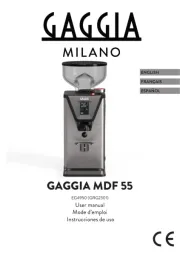
30 Juli 2025
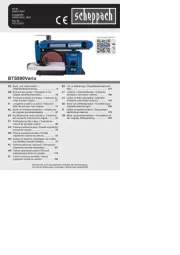
29 Juli 2025
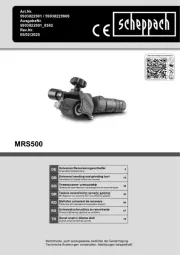
29 Juli 2025
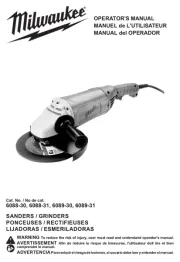
16 Juli 2025
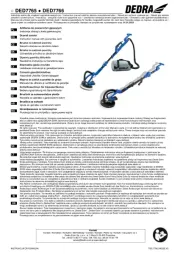
15 Juli 2025
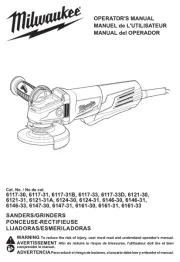
15 Juli 2025
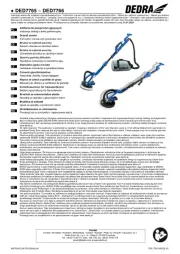
15 Juli 2025
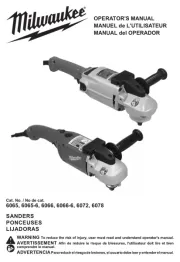
15 Juli 2025
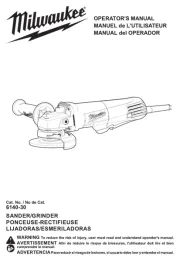
15 Juli 2025
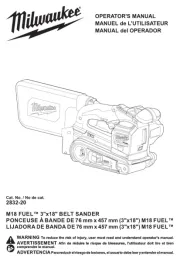
15 Juli 2025